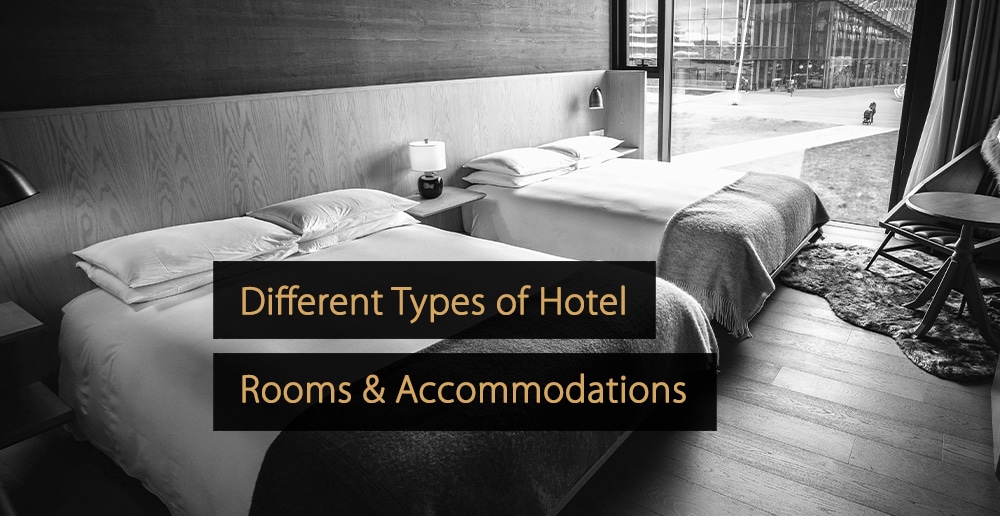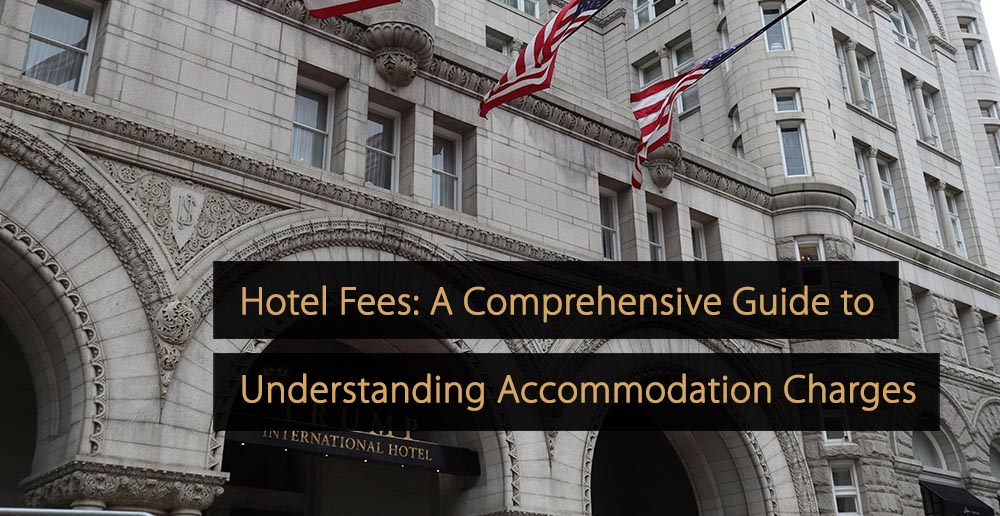Types of hotel rooms range from the simplest dorms and motel bedrooms to luxury suites and apartments. There are as many different hotel room types as there are travelers. In this article, you’ll learn everything you need to know about the range of hotel rooms and how these categories are helpful.
Table of Contents:
- What Is the Hotel Industry?
- The Necessity of Different Types of Hotel Rooms
- Most Common Types of Hotel Rooms
- 5-Star Hotels
- Is Your Hotel Cool?
- Broader Hotel Meaning when Understanding Hotel Room Types
What Is the Hotel Industry?
The hotel industry deals with overnight accommodation. It is a vast global industry, serving guests’ needs and powering local economies worldwide. Although there’s a large overlap on the Venn diagram of the hotel and hospitality industries, the hotel industry is explicitly concerned with customers who need a place to stay. The industry is enormous, covering many hotel rooms with nightly rates, suites, villas, apartments, and more.
It also includes many novel forms of accommodation that have emerged in response to today’s guests’ changing needs and demands. The hotel industry offers various careers and provides an indispensable service to customers. From housekeepers and hotel front office staff to those involved in finance and hotel marketing, every skill set has a role. To learn more, read “Hotel Industry: Everything You Need to Know About Hotels!”
The Necessity of Different Types of Hotel Rooms
Classifying different hotel rooms helps customers make informed choices when planning their stay. Providing classifications gives a clearer picture of what the hotel offers regarding accommodation and services. Rooms can be categorized using several criteria, including the room size, the expected length of stay, and the types of services provided, such as hotel breakfasts. Categorisation also helps hotels determine the appropriate number of available rooms, set room rates, and optimize staffing. The range of room types will depend on the hotel’s location and target customer base.
Most Common Types of Hotel Rooms
This section will teach you the main hotel room types and their distinct characteristics.
Types of Hotel Rooms Based on Occupancy
Many hotel rooms are categorized based on the expected number of occupants.
Single Room
A single room is generally small and is intended for single occupancy. It will typically have one single-sized bed, although some single rooms are equipped with additional sleeping facilities or may have a second bed added if required. True single rooms are declining as hotels find it more efficient to offer twin rooms.
Twin Room
A twin room is essentially the same as a single room but comes with two beds instead of one. They are generally lower than double rooms, making them an inexpensive option for two guests traveling together. If necessary, an additional bed can be added with a corresponding charge.
Double Room
A double room is intended for two people. Instead of two single beds, it will have a larger double bed intended for two people, typically queen or king-sized. This type of room is best for couples (or people who don’t mind sharing a bed).
Triple Room
Triple rooms are large enough to sleep three people comfortably. There will be two to three beds. These might be a combination of one double and one single bed, two double beds, three single beds, etc. Triple rooms are ideal for small groups or families — for example, two parents and a child.
Quadruple Room
A quadruple or quad room is a larger room intended for four guests. The arrangements in these types of hotel rooms can vary. A room for families with children might offer two double beds or one double bed and two singles. Alternatively, quad rooms may use four single beds or four dormitory-style bunks.
Types of Hotel Rooms Based on Bed Type
As well as the number of intended guests, types of hotel rooms can be categorized based on the bed type. Queen or king rooms, for instance, have queen or king-sized beds; they can comfortably accommodate two adults. A Hollywood twin room offers two single-sized beds alongside a single headboard. There are various other combinations, such as a Double (Double) room. This is a room with two queen-sized beds. This type of room would be a good choice for a family traveling with their younger children, allowing the parents to share one bed while the children share another.
Basing categories around bed types rather than expected occupancy can be helpful for guests who need to know exactly what kind of sleeping accommodations are on offer. For instance, knowing whether a room has two large beds or four small ones might be more informative than the designation of a quad room.
Types of Hotel Rooms Based on Room Layout
Rooms can also be categorized based on their arrangement and the facilities offered.
Studio Room
A studio room offers all the amenities of a small apartment, plus a studio bed. This convertible bed can be turned into a sofa or furniture. A studio room is ideal for longer-term stays.
Duplex
A duplex suite comprises two rooms on separate floors, with a private staircase or lifts between them. A duplex is a good choice for a guest such as a business traveler who wants to work or hold meetings in one room and sleep in the other.
Deluxe Room
A deluxe room will generally be larger and more lavishly appointed than other hotel rooms. They will often have additional features such as a whirlpool bath, a private patio or balcony, or a particularly outstanding view. The cost will also be higher.
Adjoining Room
Adjoining rooms are next to each other and feature connecting doors. They will also have separate entrances to the main corridor. Adjoining rooms are ideal for groups who require separate sleeping spaces at night but who want a single larger space during the day.
Apartment-Style Room
Apartment-style rooms are designed for longer stays. They are arranged so guests can prepare meals and enjoy a comfortable stay. Housekeeping services are typically restricted to two or three visits a week. This type of room offers a comfortable home away from home.
Suite
Suites typically have two or more rooms, at least one bedroom, and a sitting area. Less commonly, a suite may be a larger room with distinct sitting and sleeping sections. A suite usually aims at more affluent customers and commands a higher price; the upscale amenities will reflect this.
Junior Suite
A junior suite is smaller than a standard suite. It may incorporate two smaller rooms or use a one-room layout with distinct areas for sleeping and living. The layout will vary between establishments. A junior suite will be well-appointed and offer upscale amenities.
Presidential Suite
As its name implies, a presidential suite will be more impressive than a standard suite. Only an extremely luxurious hotel will have more than one or two such suites available. They are important for hotel marketing strategies. A presidential suite will consist of multiple rooms with opulent furnishings and amenities.
Video: Presidential Suite | The Ritz Carlton Hong Kong
Penthouse Suite
A penthouse suite often takes up one entire hotel floor, usually the topmost. The height of luxury, penthouses are among the most exclusive (and expensive) types of suite. They are often accessed by a separate private lift that requires a key card to enter.
Bridal Suite
A bridal suite is usually large with big, open rooms. Bridal suites will typically have flexible facilities and work areas for wedding preparations to accommodate a bride and her party as they prepare for the ceremony. Hotels with bridal suites often specialize in catering for wedding groups.
Honeymoon Suite
A honeymoon suite is a staple of the hotel industry. It’s a romantic suite that comes with special services aimed at newlyweds. Champagne and roses might be provided, as well as private dining options and other romance-themed services such as couple’s activities and excursions.
Cabana
A cabana is a hotel room that opens onto a beach or a swimming pool. Sometimes, the pool may be private and reserved only for the guests in that room. Cabanas are usually furnished in a luxurious style. Some have private balconies that allow beach access.
Villa
A villa is distinct from conventional types of hotel rooms. It’s a private hideaway that’s usually detached from the main hotel. Villas are usually located in a picturesque part of a hotel’s environs and offer seclusion for affluent travelers. Villas may be on the hotel grounds or in a scenic location nearby.
5-Star Hotels
5-star hotels are some of the most lavish and luxurious places to stay. As well as the finest architecture and decor, these hotels offer opulent amenities and the best in personal service. If this article on different types of hotel rooms has piqued your curiosity, you’ll want to learn more.
In “5-Star Hotel: Overview and Features of Five-Star Hotels” you’ll discover what it takes to gain that coveted 5th star. Find out about the spas, gyms, and gourmet dining and the service that puts these hotels a cut above the rest.
Is Your Hotel Cool?
In today’s rapidly changing hotel industry, the same generic accommodation isn’t enough to attract those searching for character. A hotel can be cool with themes, concepts, and locations with that “Wow!” factor in many ways.
In “Cool Hotels: What Makes a Hotel Cool and What are Some Examples?” you’ll learn about some of the industry’s most special and unusual hotels. Find out about cool hotel trends and learn how your business can maximize its own cool factor. Learn how to identify the cool features that will put your business ahead of hotel marketing trends.
Broader Hotel Meaning when Understanding Hotel Room Types
You’ve discovered some of the different types of accommodation that hotels offer. Now it’s time to learn more about hotels themselves. If you’re working or planning to work in a senior role, such as hotel management, you’ll need a good understanding of what defines a hotel and the different kinds of hotels out there.
In “Hotel Meaning: Learn About All the Various Hotel Types”, you’ll be introduced to the history of hotels as a concept — how they started and gradually developed into the hotels we know today. You’ll learn about the different features of various hotel types and the kinds of customers they serve.
There are various accommodation types in today’s hotel industry, with more always coming along. In this article, you’ve learned about some of the most common types, their definition, and the types of clientele who might stay there.
More Tips to Grow Your Business
Revfine.com is the leading knowledge platform for the hospitality and travel industry. Professionals use our insights, strategies, and actionable tips to get inspired, optimize revenue, innovate processes, and improve customer experience.Explore expert advice on management, marketing, revenue management, operations, software, and technology in our dedicated Hotel, Hospitality, and Travel & Tourism categories.
This article is written by:
Hi, I am Martijn Barten, founder of Revfine.com. With 20 years of experience in the hospitality industry, I specialize in optimizing revenue by combining revenue management with marketing strategies. I have successfully developed, implemented, and managed revenue management and marketing strategies for individual properties and multi-property portfolios.









Leave A Comment